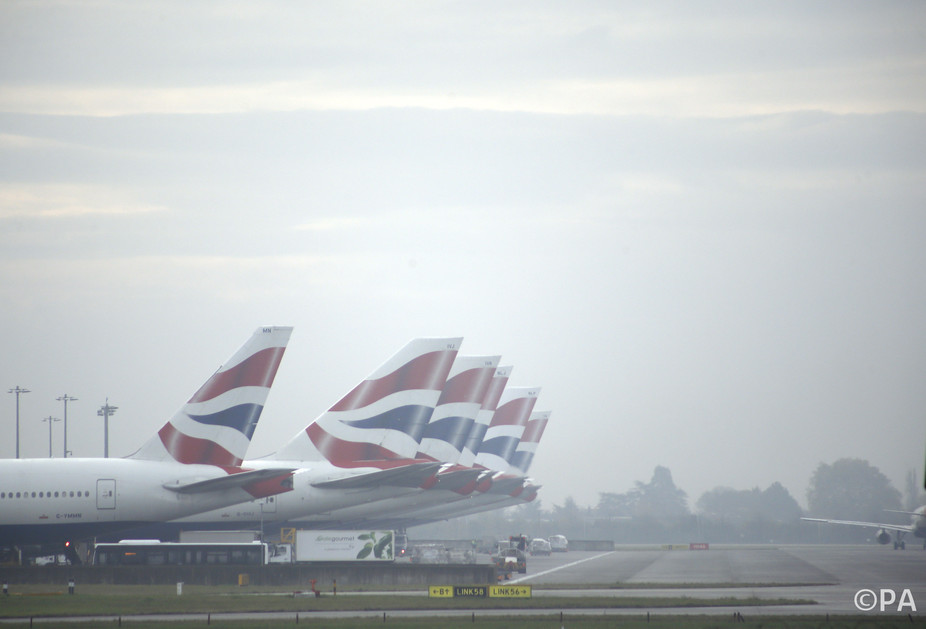
Date: 2024-12-21 Page is: DBtxt003.php txt00013737
Transport: Infrastructure
UK / London / Heathrow Airport
Why Heathrow’s hopeless flight plan will struggle to take off
Burgess COMMENTARY
Peter Burgess
Why Heathrow’s hopeless flight plan will struggle to take off

Grounded. Steve Parsons/PA Wire
Heathrow’s refurbished Terminal 2 was unveiled to much fanfare earlier this year. Officially re-opened by the queen, the shiny new terminal even provided the studio for an episode of the BBC’s weekly Question Time programme.
Although present on the TV show, actual discussion about Heathrow’s new terminal and especially the issue of airport expansion was brief. But the implication of using T2 as their stage was clear: Heathrow, for all the talk of considering different options for airport expansion in the UK, remains at the centre of the airport debate. It was a PR coup for the UK’s busiest airport, but only a curtain raiser for their third runway campaign that is set to become more strident in the run up to the 2015 general election.
All UK politicians tremble in the face of the Heathrow question. One ill-considered statement can immediately unite the business community, the surrounding constituency or the very vocal green lobby in high profile anger towards them.
It was partly for this reason that HS2, a proposal for a new high speed rail system connecting the North and middle of England to the capital, was introduced in 2010. The flawed logic of HS2 was that air passengers could be persuaded to take the train rather than the plane, thus freeing up capacity at Heathrow. But nearly 40% of passengers using the Heathrow hub are transferring from one flight to another. And, apart from a handful of daily flights to Manchester, there are no direct services from Heathrow to the cities located on the HS2 route.
Had Heathrow and HS2 planners followed examples like Schipol airport in Amsterdam – and taken the HS2 line right into the airport complex – the rail connection might have worked. But this has been steadfastly resisted, perhaps because Heathrow’s managers perceive an integrated high speed rail connection as eventually opening the market to competitor airports including Charles de Gaulle in Paris via the Eurostar.
The Airports Commission was set up in 2012 to examine all the options of how best to increase the UK’s airport infrastructure. Under its respected chair, Howard Davies, an interim report concluded that the future of London’s airport facilities boils down to three options: a third runway at Heathrow, an extension of one of Heathrow’s existing runways or a new runway at Gatwick airport.
But politicians would do well to consider an alternative option: increasing capacity at airports outside of London within easy, high speed access to the capital.
A complex debate
There is no easy way to summarise the complex issues entailed in any debate about airports. The casual observer is quickly lost in claim and counter-claim about direct and indirect connectivity, landing charges, the growing threat of Middle Eastern hubs, long haul requirements versus low-cost carrier imperatives and relative land values.
But there are two key aspects to the debate. First, Heathrow’s expansion is underpinned by the simple logic of higher target revenues – it needs more customers and thus more airport space. But the downsides of this plan in terms of noise, environmental impact and road congestion are borne by the community at large.
The other persistent theme of the pro-Heathrow expansion lobby is the interdependence of the capital’s largest airport with London’s identity as a global brand. As architect Christopher Choa recently opined in the Architects’ Journal:
... This airport debate is about much more than just runways. London and the UK urgently need to secure their global gateway hub at Heathrow.
... As we are learning the hard way in all business sectors, however, modern consumers are more likely to choose benefits over things.
Alternative options for the same outcome
So before we turn the bulldozers loose across the suburbs of west London we should consider the outcome we are trying to achieve. In the case of city airports, two major objectives (or benefits) are usually in play: maintaining the brand value of connectivity for the city and not squandering the time efficiency you gain in the air on clunky and slow transfers to the city centre.
Both these outcomes could also be achieved by flying passengers to an alternative UK airport such as Birmingham and then seamlessly via high speed rail to London. This would not diminish the perception of London’s connectivity, especially if the total journey time remains the same – if not better – than the present offer of getting a train into the city from Heathrow or Gatwick.
Critically, doing things this way would signal the UK’s commitment to competitiveness which, as any business school will confirm, is dependant upon innovation. Right now policy is being built on the outdated doctrine of “predict and provide” which bases plans on current travel patterns. Refusing to innovate and expanding Heathrow will skew investment further toward London and undermine the HS2 potential.
======================================================================================
Author
Michael Synnott
Senior Teaching Fellow in Strategy and International Business, University of Warwick
Disclosure statement
Michael Synnott does not work for, consult, own shares in or receive funding from any company or organization that would benefit from this article, and has disclosed no relevant affiliations beyond the academic appointment above.
Partners
University of Warwick
University of Warwick provides funding as a founding partner of The Conversation UK.
View all partners
Republish this article
Republish Republish our articles for free, online or in print, under Creative Commons license.